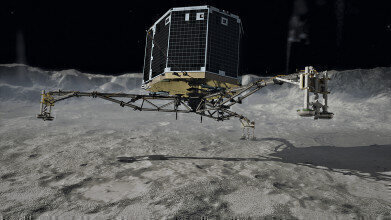News & Views
The Philae Probe is Awake. What Happens Next?
Jun 25 2015
After days on end of total silence Europe’s ultra-high tech robot lab has finally made contact with planet Earth. The Philae lander module spent several years journeying towards the sun on the back the Rosetta space probe, and has now reached its final destination. Now, Philae is making contact from the surface of its final destination, Comet 67P/Churyumov-Gerasimenko.
The host with the most
Launched by the European Space Agency in 2004, Rosetta is a robotic space probe developed to carry out a detailed study of periodic comet 67P/Churyumov–Gerasimenko. The comet chasing spacecraft has spent the past ten years trekking across the Solar System, crossing asteroid belts and travelling deep into outer space. Now the probe is located 748000000kmfrom Earth and has completed its mission of shuttling Philae to the surface of 67P/Churyumov–Gerasimenko. According to the German Aerospace Centre (DLR) Philae is “doing very well” and remains in optimal working order.
Space age solar power
Powered by the energy of the sun, Philae represent a new era of exploratory opportunity for European Space Agency scientists. After its initial landing on 67P/Churyumov–Gerasimenko Philae used its stored battery power to let Rosetta space scientists know it has arrived safely. After seven months in hibernation the robot lab has recharged its batteries, snapped out of standby mode and is gathering exciting new information. Scientists boast that Philae even has enough power to work through the night.
Michael Maibaum, a systems engineer at the DLR Lander Control Centre in Cologne reveals that “Among other things, we have received updated status information.” After almost a year alighted on 67P/Churyumov–GerasimenkoPhilae has finally settled in and can now start to function as intended. “At present, the lander is operating at a temperature of zero degrees Celsius, which means that the battery is now warm enough to store energy. This means that Philae will also be able to work during the comet’s night, regardless of solar illumination,” adds Maibaum.
The initial transmission lasted just two minutes, with the robot reawakening two days later for a second contact. On Friday June 19 Philae transmitted 185 data packets back to Earth, lasting a total of 19 minutes. It’s the third time Philae has ‘phoned home’ since touching down on Comet 67P/Churyumov-Gerasimenko last November and will not be the last.
Exploring the unknown
The European Space Agency has an insatiable curiosity for the mysteries of outer space, and Philae is the key to uncovering the secrets of comets. Scientists believe that the primordial clusters of ice and dust could reveal fascinating information about how the solar system was originally formed, and what’s in store for the future.
If you love to stay up-to-the-minute with all the latest high profile space exploration ventures, The Role of Materials Degradation and Analysis in the Space shuttle Columbia Accident Investigation offers fascinating insight into one of the world's biggest intergalactic disasters.
Image via Wikipedia
Digital Edition
LMUK 49.7 Nov 2024
November 2024
News - Research & Events News - News & Views Articles - They’re burning the labs... Spotlight Features - Incubators, Freezers & Cooling Equipment - Pumps, Valves & Liquid Hand...
View all digital editions
Events
Nov 18 2024 Shanghai, China
Nov 20 2024 Karachi, Pakistan
Nov 27 2024 Istanbul, Turkey
Jan 22 2025 Tokyo, Japan
Jan 22 2025 Birmingham, UK




.jpg)














